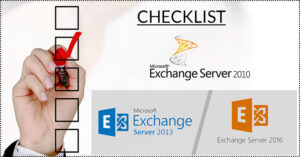In this blog, you will get to know the complete procedure to Backup and Restore mailbox in Exchange 2016/2019. This blog explains the different methods of backup and restores Exchange 2016/2019 mailbox. You also found a professional third-party tool. The professional tool can Backup and Restore mailbox of Exchange 2016/2019 in a hassle-free manner.
Backup and Restore mailbox in Exchange 2016/2019 is a tedious task if you do not have any technical knowledge. Restoring Exchange mailbox requires good knowledge of retention policies and features of Exchange Server.
If you are familiar with the Exchange Server, then you already know there are many different ways to restore mailbox in Exchange 2016/2019.
Download a trial version of Shoviv Exchange Server Backup Tool to know in a better way.
How to Backup Exchange Mailbox
The user can backup Exchange 2016/2019 mailboxes using the manual method (PowerShell command). This method helps users to import Exchange 2016/2019 mailbox to PST files. PowerShell command is a great utility as it maintains a different kind of issues in the Exchange Server. PowerShell command can back up both single as well as multiple Exchange mailboxes. Let’s elaborate briefly:
Follow the commands to backup Exchange 2016/2019 mailbox to PST format:
- For Mailbox import and export permission, use the command given below:
New-Management Role Assignment -Role“Mailbox Import Export”-User <user name or alias>
I.e. New-Management Role Assignment -Role “Mailbox Import Export” -User < Stuart >
- To export users primary mailbox data to PST enter the following command:
New-Mailbox Export Request -Mailbox < user >” -File Path \\<server FQDN >\ < shared folder name >\ < PST name >.pst
I.e. New-Mailbox Export Request -Mailbox Stuart” -File Path “\\SERVER11\ MyNetworkPST\ Stuart _Recovered.pst
- To export mailbox data using filters, use the command given below:
New-Mailbox Export Request -Mailbox <user> -ContentFilter {(body -like “*type*”) – and (body -like “*type*”) – and (Received -lt “date”)} -FilePath\\<server FQDN >\ < shared folder name >\ < PST name >.pst
I.e. New-Mailbox Export Request -Mailbox Stuart -ContentFilter {(body -like “*Task *”) – and (body-like“*Calendar*”) – and (Received-lt“19/10/2019”)} – \\SERVER11\ My Network PST \Stuart_MyOrganizationReports.pst
The above command is used for converting the email containing the “Task” and “Calendar” report received on October 19, 2019 (any specific date).
- To export a particular folder like Inbox, and Sent items, Enter the command given below:
New-Mailbox Export Request -Include Folders “#folder name#/*”,”#folder name#” -Mailbox < user > -File Path \\ < server FQDN >\ < shared folder name >\ < PST name >.pst
I.e. New-Mailbox Export Request -Include Folders “#Inbox#/*”,”# Sent items #” -Mailbox < Stuart > -File Path \\SERVER11\MyNetworkPST\ Stuart _My Organization Reports.pst
- To Backup Exchange 2016/2019mailbox to PST, use the command given below:
$All Mailboxes|%{$_| New- Mailbox Export Request -File Path \\ < server FQDN >\< shared folder name >\$($_.Alias).pst}
I.e. $AllMailboxes|%{$_|New-MailboxExportRequest-FilePath\\SERVER11\MyNetworkPST\$ (Stuart _ My Organization Reports).pst}
By using the above commands, you can Backup Exchange 2016/2019 mailbox to PST.
How to restore mailbox in Exchange
In Exchange, if you accidentally delete any mailbox will remain in the Exchange Database for 14 days. The deleted mailbox remains hidden and disconnected from the network until you permanently delete the mailbox or until the grace period is not over. In case you want to restore mailbox in Exchange 2016/2019, you can do this by using the manual method.
Drawbacks of manual method:
If you are thinking about to Restore mailbox in Exchange 2016/2019 manually, without having any backup, then you have to pursue two different manual ways. The first method (PowerShell command) to backup Exchange 2016 mailboxes. Another (Exchange Admin center)is to restore mailboxes. Manually this process is time-consuming as well as complicated. If you don’t have any technical knowledge, then the manual method will like walking on eggshells for you. In the manual method there are some limitations and drawbacks:
- You cannot backup files, which is more than 2GB in size.
- Manually you cannot back up public folders.
- Due to the technical command, the manual method isn’t recommended for beginners and non-technical.
- If you have multiple mailboxes, then it will take years to restore mailbox in Exchange 2016/2019. And you have to repeat the same process for each mailbox.
- There is always a risk of data loss in the manual method. Hence a little misstep and the mailbox data will become corrupted or inaccessible.
To eliminate the risk of data loss and tediousness of the manual method. Many Exchange users prefer a professional third party tool for the backup and Restore mailbox in Exchange 2016/2019.
Shoviv Exchange Server Backup and Restore
Exchange Server Backup and Restore tool developed by Shoviv is a mastered tool for Exchange task. It is a multi-tasking tool as it allows Exchange users to Backup and Restore mailbox in Exchange 2016/2019, and all other versions of Exchange Server. This software is a professional utility, and this software work simply and straightforwardly. Using this software has many user-centric features:
- It keeps a convenient and user-friendly GUI, which makes this software easy to access for everyone. Even a beginner and non-technical can use this software without any assistance.
- Users can schedule a backup job. After scheduling the backup job, the software will take the backup of the Exchange mailbox automatically.
- The users can use the filter option while backup and Restore mailbox in Exchange 2016/2019 or any other version.
- Shoviv Exchange Server Backup and Restore Tool expertly take the backup of User Mailbox, Archive Mailbox, and Public Folder. Having a backup of mailboxes provides a helping hand at the time if you are not able to access the Exchange Server.
- To check the software’s working efficiency and get assured about the software. Shoviv Software provides a free trial version of the Shoviv Exchange Server backup and restore Tool.
Wrapping Up:
Straight to the point, if you have numerous mailboxes and do not have a backup. Then the manual method will take months to backup and restore the mailbox in Exchange 2016. Those who want to backup and restore the mailbox in Exchange 2016/2019 in a hassle-free and rapidly. You must use Shoviv Exchange Server Backup and Restore Tool. In the end, your data your choice. Whatever you choose, choose wisely.
- How to Backup and Restore Emails in Webmail? - March 25, 2025
- How to Migrate Outlook to New Computer? - February 15, 2025
- Fix If Outlook Cannot Display the Specific Folder Location - February 1, 2025




